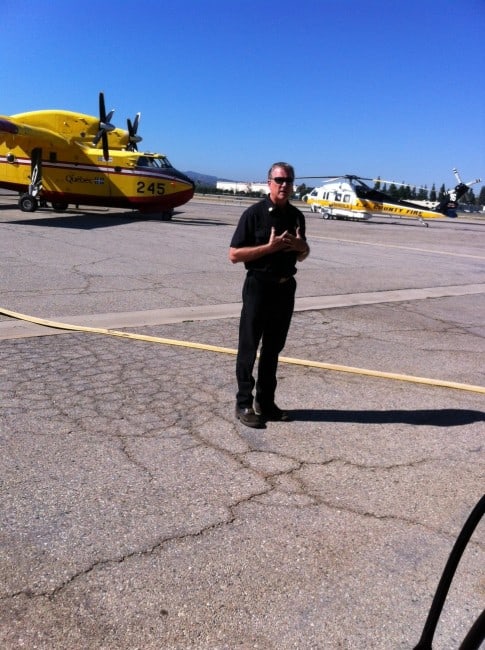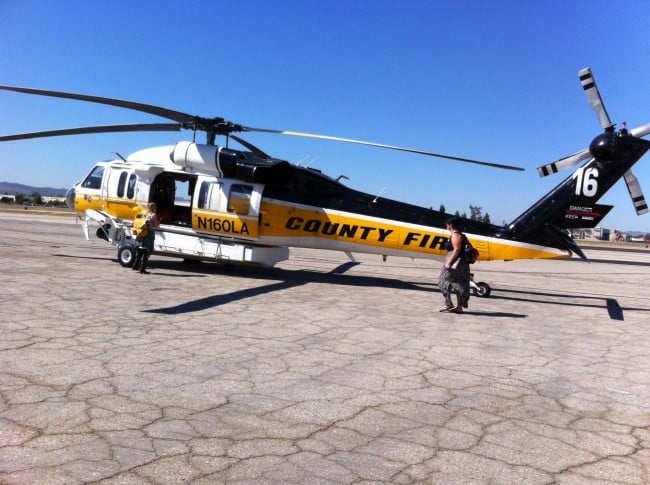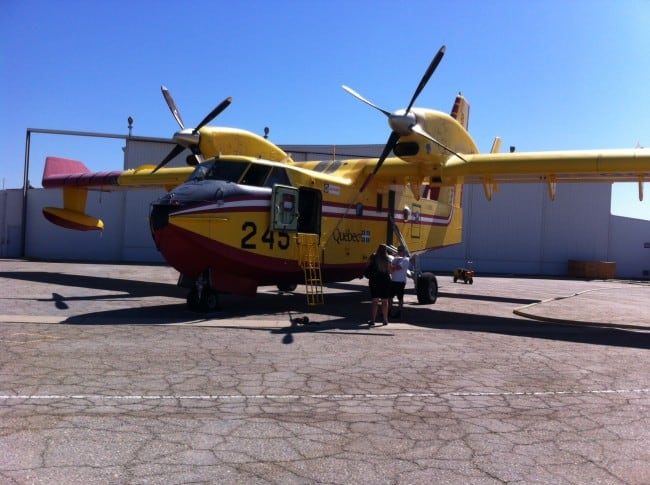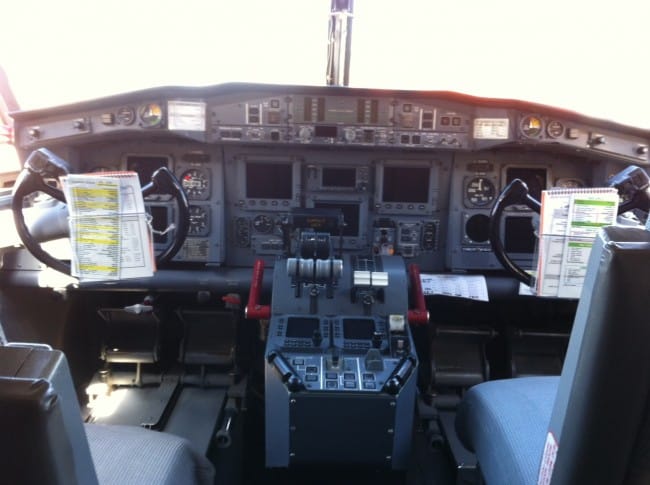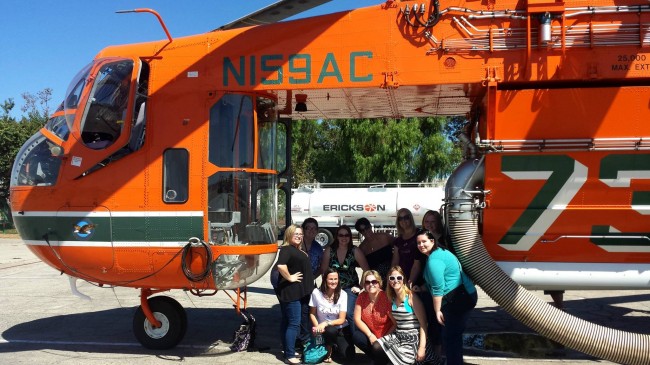PLANES: FIRE AND RESCUE- Our Visit to Van Nuys Air Tanker Base
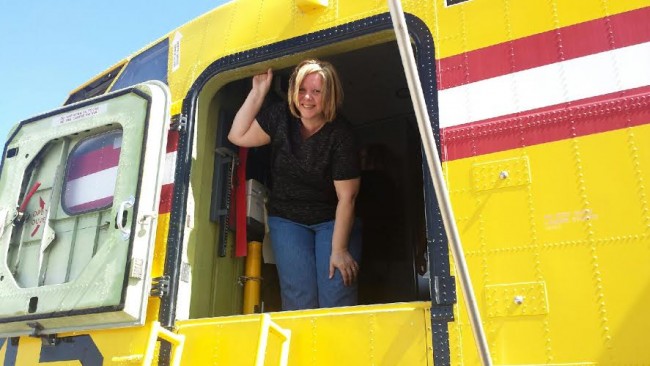
PLANES: FIRE AND RESCUE- Our Visit to Van Nuys Air Tanker Base
**Disney provided me with an full expense paid trip to Los Angeles for the #VeryBadDayEvent and #DisneyInHomeEvent & #FireandRescue in exchange for my review of the events of the trip. No other compensation is given. The opinions in my posts are 100% mine.**
Introduction from Steve Martin.
My name is Steve Martin. I’m assistant fire chief of the LA County fire Department. Three, almost 4 years ago I was battalion chief in charge of our air operations and our air operations consist of nine aircraft that we have, one of them being here the LA County on the side of it, on one of our big fire aircraft here. During the fire season we augment our fire department’s program with contract air and we’ve done that through the years for the last 21 years.
First we have what you see is the two super scoopers. They come from the province of Québec. They always come here in September and they generally can go through, depending on when the rains come, middle of November, but we’ve had them as long as into January. I think last year we had big fires in January so they were here until February. We also augment with the aircrane, this one over here. You’ve seen the movies. Obviously you’ve seen the characters based on these.
So I received a phone call from some folks that Gabby had worked with about three years ago and they said hey, you know that movie Cars? I’m like yeah. They go were going to do one on planes. And I go well, that sounds like a cool idea. But the Disney folks are so square, they go yeah, we’re working for 2014, 15 and 16, like way out. So they were just doing, at that time, investigating it and fact gathering and wanted to know some things. So like I said I’ve got to give props to the Disney people. They do their homework.
One of the things was I said, well, now here. You can look at our aircraft that we have; take a look at this aircraft here which is highly visible during the brush and forest fire seasons that we have here. So they came out and they met our folks just like you did today, came here to the facility. They met some of the pilots, the maintenance crew. They walked around the aircraft . They had them fire it up. They listened to the sound of it. They watched it fly. I think some of them even took a flight in it. They really, really did their homework.
They went back to the offices, called me a few weeks later, hey we miss a little something. Can we come back again? Sure, come on out. So we had been out here a few times and after that time what they did was they started sending me information what looked like early scripts. They would send me a script and they highlight, is this the proper word? Is this what terminology you would use? Is this what you– what would you say in this case? A lot of times they would scratch something out and I’d say no, no we don’t talk like that. This was good. And we help them, I guess that’s what you, know, the definition of someone being a technical advisor.
Basically they make a movie but they wanted to be technically correct. If I look back and I think when my son was young and I go to Disney movies and it’s something that I don’t know a lot about, it sure sounded like it was correct. But in this case here when it was about the aircraft and it was about flying, it was about the fire department, it was about rescues, we knew the language that we speak. And they took every single one of those things that I said and put it in the script and change the script.
Of course I didn’t know what the final product would be until the movie came out. So the movie came out middle of summer okay. Next thing I know my e-mail is blowing up. I’ve got people that said hey, I went to that Planes movie. And I saw your name on there. And I’m like really? They put my name on there? And they go yeah, LA County. How big was it? Was it big? Was it going fast? Was it like after a TV show or was it real slow with something funny happening? He said, no its slow. It was big.
The one thing everybody has said to me is that yeah, that movie was technically correct. Anybody in the fire service who knows from the political overtones of it to the vernacular they used during the flying or rescues or hoists, whatever it was they did, they took all those changes that we put down and gave them and did not embellish on it. Put it exactly like it was. So again, that made me feel good because the last thing I want to do is have something out there that my boss goes hey, did you tell them to say that? And you know I wouldn’t be an assistant chief anymore. I’d be washing this right now. It’s actually a good job.
So today what we’re going to do, Gabby asked me, while I have you out here, we’re also going to, from what I’m understanding from her is, is that she’s going to release this– the whole DVD– is he with me? I always have friends visit me from places. It’s weird
This is one of the plane tricks we do here. That’s why I don’t fly the aircraft. You alright? We’ll take a picture of that. Okay. So what they’re going to do is release this to home she said during the fire prevention week. So I know all of you have probably looked it up and googled that. The fire prevention week is the second week in October, which coincides with what? Why is that an important week? Anybody remember?
Great Chicago Fire and The Why of Fire Prevention Week
Great Chicago fire. Threw that one at you. The history of the great Chicago fire. So since that time across the nation they’ve taken that week for fire prevention. And what we do in our department basically, that is our home fire prevention programs and things that we do all year round, they’re just more highlighted during this time of year. So I do have my PIO here. I have Captain Scott Miller here, to speak to some of the fire prevention you know, aspects, home fire prevention, things that we do and we can show you what it is that we tell the citizens of LA County, whether we go out to the schools or we go into the convalescent homes or we go to city fairs.
Wherever it may be, this is the kind of information that we provide to them and then he’ll also tell you how to pull up that information on our website. If anybody wants to be connected to the website we have a fantastic website with all this information on it. And then for one of the nice drills we’re going to do is we’re going to give you a fire, a home fire extinguisher demonstration that one of our gentlemen is going to do. It will probably do is put the group in half so that he can speak to you here and then we’ll go around the side. We have a pan that has fuel and we’re going to ask for a couple of volunteers here to come out here and see if they can put the fire out in the pan.
Yeah, you’ll like these guys. They’re French Canadian. Somebody come over and speak French Canadian. These guys have the greatest accent in the world. Talking to them out here is fun. Now we’re in the air, were flying the aircraft and they have these little voices. Gabby and I are like I have no idea what he just said. If you haven’t had a chance to see what these folks can do live I would google them. You can Google, hey super scooper, it pops up.
There is some amazing videos of these guys picking up water in the smallest area of water that you can imagine, skipping down into it, picking it up and then putting it pinpoint on the fire or where it’s supposed to be ahead of the fire.
QUESTION : Is it automated when you pinpoint?
No, its all manual. It’s all hand flown like everything and then we drop that it’s all visual as well. It’s all manual. It’s all by training and experience. We been doing this for quite a long time, since the ’60’s in Québec. The airplanes evolved a bit but yeah, it’s all been passed on from senior pilot to some younger pilots.
Well they have the best experience because where they’re at in Canada and the other places they go to have huge timber fires . Years ago the fires would burn here and in the rains might come put it out. It might put it out, it might not. But now because of the amount of homes that we have built up in the interface, it’s important for us to jump on that fire as small as it is.
And we found that one of the most effective ways is the aircraft and this aircraft over here and even the one we have all year round. Now that aircraft over there also acts as an EMS or emergency medical services. So that’s a 24 hour fire shift that we have for anywhere in LA County where someone’s injured, they need to be taken off the mountains by hoist. You probably saw that in the movie. That would be the fire Hawk aircraft here. We bring these aircraft in here strictly to drop water on the fires as fast as they possibly can.
So when you have a small fire, because every fire starts basically small but when we talk 100,000s of acres that runs across Malibu to the ocean or thousands of homes in the way this is what we need right here. Like I said it might’ve been a cartoon but if that’s what you saw, they are very, very realistic as far as what they do, how they talk and what they did.
Steven Martin continues to tell us how many Hawk aircraft there are: We have the two. There’s only two in Southern California. Yeah, they fight fire all year round because when we are not fighting fire here there’s other places. What are some of the places in the world you guys?
One of the Canadian fire fighters said: We said, well I mean those airplanes, not that we own them but there’s some in Europe, Espagnol, everywhere in France. Basically we just parked them in Québec and sometimes we go on contracts all around Canada and sometimes in past years we’ve went to Portugal, Turkey and places like that.
Yeah, but these airplanes are, we own 14 of them and until like end of August, early September, they’re all in Québec in profits because we need them because we have a pretty big summer fire season.
QUESTION : Do you take those airplanes by flight?
MALE : Yeah, they’re all flown.
STEVE MARTIN : From the minute that they cross from Canada into the United States, they let us know, okay your aircraft is going to be there on this day are on their way. We actually pull them up on the computer. We track them. We assist if there’s anything that we can do because basically now they’re on the clock for the LA County fire Department. So there’s a fine line between when they are theirs and when they are under lease by us. So we have to be there to help facilitate it if there was something– I mean there’ve been times when they were going home. There was a problem with the aircraft because again they’re flying it. It’s like driving across country, you get a flat tire.
They’ll fly, they’ll have a little problem. They’ll have to land. They’ll have to stay somewhere. They’ll have to be taken care of while they’re there. Yeah, they’re self-contained in their aircraft from the time they get here. But what they bring out and tell me if they have to they rotate their crews. They come in here and they bring in, at the time they come up rig. Then those crews go back to Canada and they bring in a whole new set of crews. And only if it’s a really long fire season while the first cruise, which are you guys right, get to come back.
Then as one of the crew explain personally some of the guys– I’ll be back in mid-November. If the contracts get extended like last year it went all the way to March because it was a drought and there was quite a bit of fire. So all the crews were kind of rotating all winter. Everybody was quite happy because it was quite cold and snowy.
STEVE MARTIN interjected that they’ve gone home as early as in November back in the day when used to rain in Southern California. They would go home as soon as the first rains would come. In my time it was here, they went through December and into January.
Even if we had a little rain we were watching the weather forecast so we know that everything is dead so if it’s going to keep up again even after a small rain, that’s not going to help. Last year we had our biggest fire of the year in January. It was a fire in the foothills above Glendora in Azusa called the Colby Fire. That fire raced through the air with over 3000 acres in a matter of four hours, right into the homes. Because of the help of these aircraft here and the pictures, if you’ve seen that flag, five structures were lost in four of those were in places that we would’ve never got to anyway up in the mountains because of the amazing saving of people’s homes and properties, no injuries, no deaths.
A big part of that was these folks scooping out the Santa Fe dam which is just below there. Again I ask you to go Google super scoopers and you’ll see there’s a whole bunch of stuff and they’ve got the coolest videos.
STEVE MARTIN : Yeah, you think the guy, he’s there to water and he comes through and they pick up and then you can see the fire in the background and they go over and drop. It is amazing, amazing picture. But that was the kind of stuff that the Disney folks did what they wanted to know what they did.
So the year that you were out here we had quite a few fires that summer. So every time they have fires I get a call from Disney and they’d want to ask them questions. They’d want some pictures and again I just kept feeding it to them and never knew you know what the outcome would be of the product until the movie came out that summer. Again, we, from a technical side, were very, very pleased, very pleased.
Inside of the cockpit, as you see, were so many controls. It is amazing to think that the pilot knows exactly what they all do in order to fly the helicopter. There is also quite a bit of room for them to move around; although the farther back in the helicopter you went the shorter it got. The super scoopers could drop 1600 gallons in 12 seconds, can you imagine ?
We all had a chance to put out a fire with a fire extinguisher?. We had to have hard hats on, fire retardant gloves and safety goggles. It was quite a different experience. It is also important to have safety boots on, and not open toe (as you can expect we weren’t totally prepared).

Firefighter Martinez was very patient with us… well until we seemed to take forever to get the gear on. I am sure that was due to our time constraints.
Since we were broken into groups; we got a picture in front of the
Disney’s Planes Fire and Rescue comes out on November 4, 2014 on Blu-ray and DVD.
What's Your Reaction?
Newly middle-aged wife of 1, Mom of 3, Grandma of 2. A professional blogger who has lived in 3 places since losing her home to a house fire in October 2018 with her husband. Becky appreciates being self-employed which has allowed her to work from 'anywhere'. Life is better when you can laugh. As you can tell by her Facebook page where she keeps the humor memes going daily. Becky looks forward to the upcoming new year. It will be fun to see what 2020 holds.

